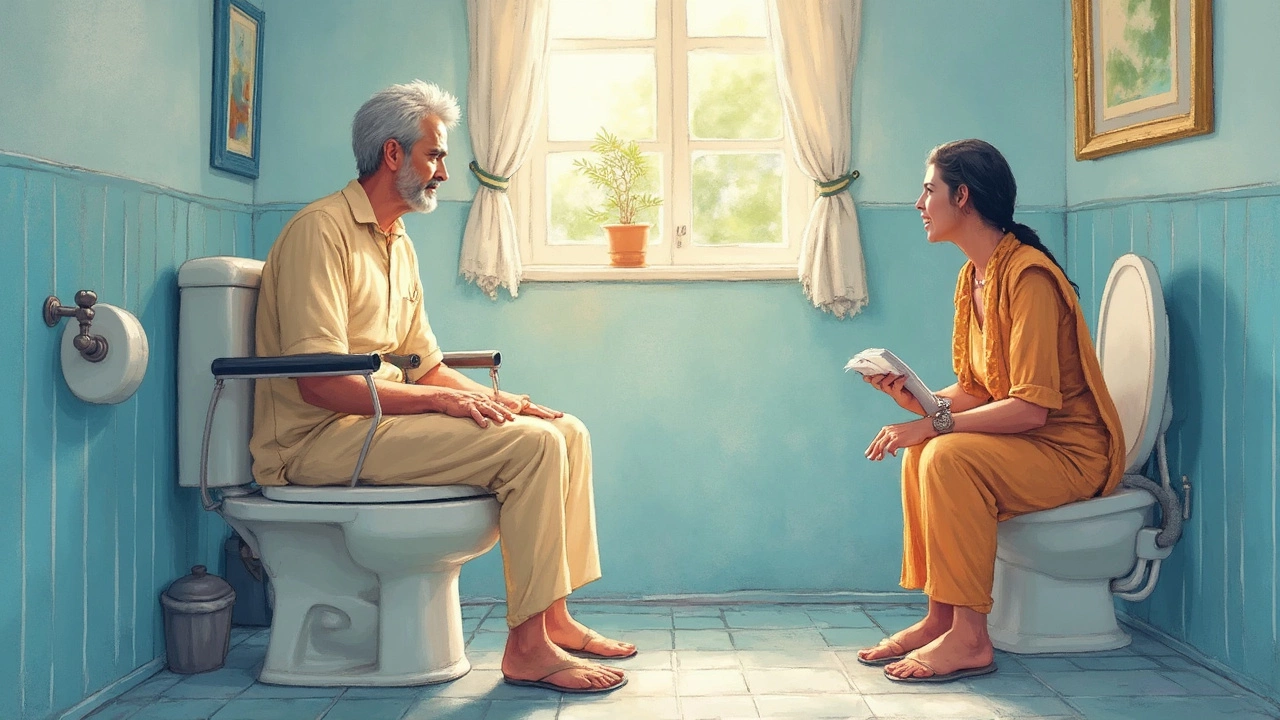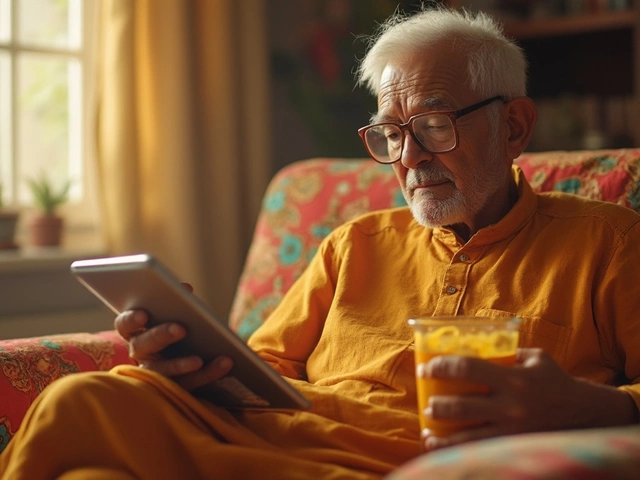
There's not much that makes you feel more vulnerable than having to ask, “How do I pee after knee replacement?” Right after the op, even the thought of moving can make you grit your teeth. Turns out, nobody tells you about the small stuff, but those first trips to the loo matter more than you might expect. You want to avoid pain, falls, or accidents—and yes, you want to keep your dignity intact. Let’s talk about real-life solutions, and why something as basic as peeing becomes an epic challenge after knee surgery.
What Makes Peeing Tricky After Knee Replacement?
Try picturing the scene: you’re back from surgery, your new knee feels like it weighs a ton, and just swinging your legs out of bed quickly seems like a distant memory. The biggest culprit is the pain and stiffness in your knee. That, plus the swelling that comes right after surgery, makes bending or standing tricky. Everything simple—like pulling down your pants or sitting on a toilet—suddenly feels like a mission. Some folks also experience trouble because of swelling in their leg, numbness around their knee, or the side effects of anaesthesia or pain meds, which can slow your bladder.
Hospitals know about this struggle. According to NHS data, about 25% of knee replacement patients report trouble using the loo in the first week post-op. Not just the knee plays a role; painkillers can make you pee less for a while, or give you constipation, adding another layer to that bathroom drama.
Gearing Up: Prepping Your Bathroom Before Surgery
Getting your bathroom ready before your knee replacement could save you a world of hassle later. Here’s the thing—your home loo isn’t usually set up for someone who can’t bend a knee much or can’t put weight on a leg. The best move is to add a raised toilet seat. This simple gadget, usually found at chemists or medical suppliers in Birmingham and likely covered by NHS home care, boosts your usual seat by 3-5 inches. The difference? You won’t have to bend so far, sparing the new joint.
Think about grab bars too. A lot of people assume they’ll be fine, grabbing a sink or towel rail. Don’t do that—a towel rail isn’t made to hold your weight. Install proper grab bars next to the loo and shower, or get a sturdy toilet frame. Check the lighting; you really don’t want to trip at night because you couldn’t see your feet! Remove bath mats or loose rugs, too, since they love to trip folks when they’re not steady on their feet.
If all that sounds overwhelming, ask your hospital’s occupational therapist for an assessment. They’ll spot hazards you might not even think of—like toilet paper being too far away, or your flush lever being on the wrong side if you can’t twist your knee well. These tiny changes take minutes now, but will save you a lot of pain and panic after the op.

How To Actually Pee Right After Knee Replacement Surgery
Let’s get down to it. You wake up after your operation and—surprise—the nurse may hand you a bedpan or urinal bottle. Most UK hospitals push to get you up and walking (well, limping) quickly after surgery, thanks to something called Enhanced Recovery After Surgery (ERAS) pathways. Some folks will use a commode chair first; it’s like a chair with a toilet seat and a removable bucket, and staff help you get on and off.
Once you’re home, your GP or physio’s advice will shape how much pressure you can put on your leg and how much you should bend your knee. Here’s where the real tactics come in:
- Use a walking frame or crutches to steady yourself every time you walk to the bathroom for the first two weeks.
- Don’t rush—give yourself extra minutes, especially at night. Pain plus grogginess is a recipe for a fall.
- Keep the lights on so you aren’t fumbling. Nightlights can help.
- When you get to the bathroom, back up until the back of your legs touches the toilet. This helps you judge distance.
- Place one hand on a grab bar or frame for support; if possible, back into sitting, then extend the operated leg slightly forward as you sit to ease pressure on your new joint.
- Lower yourself slowly—some people even say counting ‘one, two, three’ helps signal your body not to panic about the movement.
- Take off trousers or underpants before trying to sit. Bunching them at your ankles will only trip you up.
Guys often ask, “Do I have to sit?” Yep, sitting is safest for the first week or two post-op. You’ll have more balance, less risk of tipping over, and—let’s be honest—your aim might be off if you’re using crutches and painkillers. If you just can’t face the trek to the loo, use a urinal bottle or bedside commode for a few days.
Something people don’t expect: the urge to pee can sneak up, but the flow itself might be slow. This is partly down to swelling, partly medication. If it gets uncomfortable and you can’t pee at all, tell your doctor fast—you might be dealing with urinary retention, a known after-effect for about 10% of knee replacement patients.
Getting Back to Normal: Tips for the Weeks After Surgery
The first two weeks are usually the toughest. By week three, your physio will likely have you walking more, sometimes even without the walker. But don’t ditch your bathroom gadgets too soon—falling because you’re too confident is sneakily common among folks in their 50s and up.
One under-rated issue? Getting your clothing choices right. Joggers, pyjama bottoms, or loose shorts are so much easier to get down and up than jeans or trousers with fiddly waistbands in the early days. If you live alone, put a sturdy chair right outside your bathroom. That way you can catch your breath if you get tired, or park yourself while you re-dress.
The NHS says most people are mobile enough for a normal bathroom routine by three to four weeks post-op, but everyone heals differently. Staying on top of your pain meds, doing your prescribed exercises, and keeping the swelling down all help make bathroom visits less stressful. And don’t be ashamed to call for help—even if it’s just a mate or family member hanging about in the hallway in case you wobble.
- Keep a water bottle handy to avoid dehydration (which can make you constipated or dry up your bladder, slowing everything down).
- Do your leg raises and ankle circles—these simple physio moves stop clots and keep swelling away, so standing and sitting gets easier day by day.
- If you’re dealing with constipation (a not-so-charming side-effect of opioids), ask your GP about safe stool softeners. Straining on the loo won’t do your new joint any good.
- Don’t lock the bathroom door just in case you need fast help, but keep your privacy with a sign or a heads-up for anyone else at home.
Asking for help on toilet trips is awkward, but it beats risking a fall and another round of hospital slippers and cold breakfasts.

Real Questions Men Ask About Peeing After Knee Surgery
You’re not alone if you’re wondering things like, “Should I buy a urinal bottle if I live alone?” or “How will I manage if I need to pee suddenly in the night?” These are questions most blokes are too embarrassed to ask in the clinic, so here’s the straight talk.
- Yes, keep a urinal bottle by your bed for the first week or two, especially if you live on your own or if your bedroom’s upstairs and the loo is downstairs. Practise using it with dry runs before your surgery. Really—on day one of recovery, you won’t feel like improvising.
- If in doubt, invest in a portable commode chair—even the basic folding types are a lifesaver when stairs or midnight urgency become a challenge.
- Set up a temporary bedroom downstairs if your bathroom is on a different floor, at least for week one. Stairs are a hazard you just don’t need while drowsy from painkillers.
- Worried about privacy or having family around? Simple fix: arrange a bathroom timetable or agree on privacy signals. Nobody likes to talk toilet routines, but being honest saves stress and awkwardness later on.
- If you’re back at work or out and about, plan public bathroom stops in advance. Disabled loos are larger and have grab rails—ask for a Radar key from your council for access.
- Hydration matters—low fluid intake slows recovery and makes you tired. Aim for 1.5–2 litres a day. Yes, you’ll make more trips, but your body will thank you.
Sneaky tip from seasoned knee patients: carry a pack of cleansing wipes. They’re way easier to use when you can’t bend as far, and they’re less painful on skin that’s a bit more sensitive post-op.
If peeing becomes painful, too slow, or is followed by burning, don’t shrug it off—it could be a urinary tract infection (UTI), which is more common after joint surgery, especially if you used a catheter in hospital.
Most people do get back to their usual independence, but it’s rarely instant. Peeing after knee replacement isn’t glamorous, but no one wants to end up back in hospital because they tried to tough it out without asking for help. The secret? Think ahead, set up your loo, and don’t try to be a hero that first week.





Rohan Talvani
I am a manufacturing expert with over 15 years of experience in streamlining production processes and enhancing operational efficiency. My work often takes me into the technical nitty-gritty of production, but I have a keen interest in writing about medicine in India—an intersection of tradition and modern practices that captivates me. I strive to incorporate innovative approaches in everything I do, whether in my professional role or as an author. My passion for writing about health topics stems from a strong belief in knowledge sharing and its potential to bring about positive changes.
view all postsWrite a comment